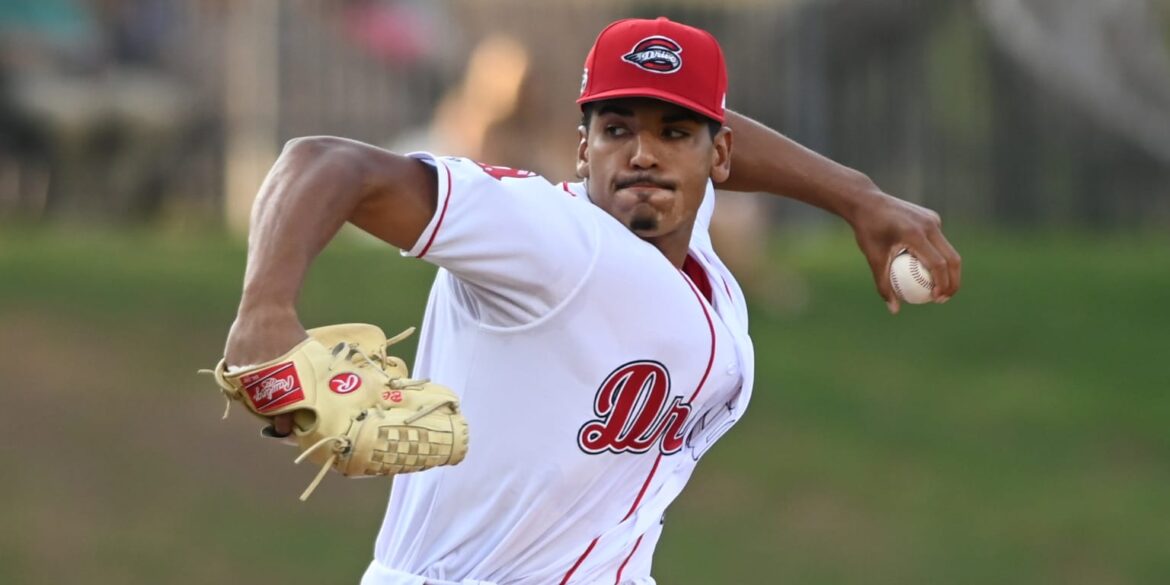A little over a year after the 2024 Draft, the Red Sox have to be pleased with their early returns.
First-rounder Braden Montgomery became a key trade piece in the deal that landed ace Garrett Crochet, and second-rounder Payton Tolle has already made his big league debut and ranks as MLB’s No. 28 prospect.
Even more talent is on the way. Three rounds after snagging Tolle, Boston landed another southpaw, one who has as much upside as any pitcher in the system: Brandon Clarke.
COMPLETE RED SOX PROSPECT COVERAGE
Although he’s only pitched 38 innings in pro ball, Clarke’s upside is quite clear. Six-foot-4 lefties with fastballs that touch triple-digits are hard to find, especially with his athleticism and a potentially double-plus secondary pitch.
The Virginia native, who grew up a Red Sox fan, showed enough to rise to become the club’s No. 5 prospect after beginning the season at No. 29. If he answers some of his biggest questions, he could make another massive leap in 2026 — into the Top 100 as one of the better left-handed pitching prospects in the game.
What makes him stand out as a prospect?
Scouts have been dreaming on Clarke’s potential since he was touching 97 mph in high school, and he’s added another three tickst since. The 22-year-old unleashes it from a three-quarters release point, and his long arm action, high leg kick and elite extension add a bit of deception. The pitch doesn’t get as many whiffs as you might expect, given the velocity, but the downhill plane on the pitch has enabled him to rack up massive ground ball numbers.
In high school and at the State College of Florida, Clarke wielded a curveball and changeup, but his best secondary pitch since turning pro has been a wipeout slider. The offering averages 88 mph and touches 91 while garnering a miss on an outrageous 63 percent of swings and drawing a 33 percent chase rate.
What are the biggest obstacles to reaching his ceiling?
Clarke’s stuff is tantalizing, but he doesn’t have much of a track record. He underwent Tommy John surgery as a high school junior, and thoracic issues forced him to redshirt in his lone season at Alabama. He only pitched 78 total innings across two seasons at the State College of Florida, although he was perhaps the country’s best juco pitcher in his final season.
When he has been healthy, Clarke has struggled with his control. He issued 27 walks in 38 frames — including an alarming 18.1 percent walk rate at High-A — and only threw strikes 56.8 percent of the time, putting him in the sixth percentile of Minor Leaguers in full-season ball. He has the athleticism to approach average control in the future; it just hasn’t manifested yet.
Who is a reasonable comp at the MLB level?
Evaluators are split on whether Clarke will stick as a starter in the Majors. All 14 of his pro outings were starts, but he averaged fewer than three innings per start and never went five full frames. He still has room to fill out his frame and build up stamina, although the bigger concerns are his lack of control and an effective third pitch.
If he’s able to sharpen his command, especially on his fastball, and improve his curveball or changeup to become league-average, you’re looking at a starter with flashes of brilliance along the lines of Francisco Liriano. But even if he doesn’t, his fastball-slider combination should still give him the tools to be a late-inning reliever like Tanner Scott. Worst-case scenario, if his velocity backs up, he could still be a swingman in the mold of Sean Newcomb.
When should we expect to see him in the majors?
Clarke still has plenty of development left and will likely return to High-A Greenville to start the 2026 season. Given that he’s only thrown 116 innings the past four years — and that’s not even counting time he missed from Tommy John surgery — he’s got a lot of innings to make up.
Boston can and should give Clarke every chance to start, which means more patience. A conservative schedule puts him in the Majors by mid-2028 — one promotion per season. If the Red Sox decide to shift him to the bullpen, he could potentially make it earlier, especially if needed as a weapon for a potential 2027 playoff run.
